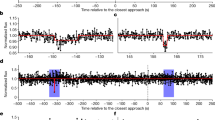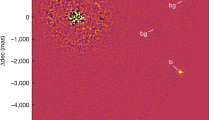Abstract
Rings formed with the birth of a planet are thought to arise after planetary condensation, from material remaining within the outer accretion limit—which has a radius of approximately two planetary radii, depending on the density of the material and the relative size of the particles1,2. Although the initial distribution of particles would be spherical, collisions would cause rapid evolution of the particle orbits into circular orbits in the equatorial plane of the planet3. Also, gaps might form at the position of strong resonances with the planet's satellites, in an otherwise broad ring. Observations of planetary rings at high spatial resolution have revealed a more complex situation. The nine confirmed uranian rings are narrow, not broad, and most have elliptical orbits, not circular. Furthermore, the Voyager observations have shown that Saturn's rings consist of a multitude of narrow ringlets, at least some of which have elliptical orbits. Here we report an additional feature that we have found for the uranian ring orbits, not predicted by current theoretical models: at least seven of the nine rings have orbits inclined to the equatorial plane of Uranus.
This is a preview of subscription content, access via your institution
Access options
Subscribe to this journal
Receive 51 print issues and online access
$199.00 per year
only $3.90 per issue
Buy this article
- Purchase on Springer Link
- Instant access to full article PDF
Prices may be subject to local taxes which are calculated during checkout
Similar content being viewed by others
References
Smoluchowski, R. Nature 280, 377–378 (1979).
Elliot, J. L. et al. Nature 294, 526–529 (1981).
Burns, J. A. in The New Solar System, 129–142 (Sky Publishing, Cambridge, Massachusetts, 1981).
Elliot, J. L., Dunham, E., Wasserman, L. H., Millis, R. L. & Churms, J. Astr. J. 83, 980–992 (1978).
Nicholson, P. D., Persson, S. E., Matthews, K., Goldreich, P. & Neugebauer, G. Astr. J. 83, 1240–1248 (1978).
Elliot, J. L. et al. Astr. J. 86, 127–134 (1981).
Nicholson, P. D., Matthews, K. & Goldreich, P. Astr. J. 86, 596–606 (1981).
Nicholson, P. D., Matthews, K. & Goldreich, P. Astr. J. 87, 433–447 (1982).
Elliot, J. L. et al. Astr. J. 86, 444–445 (1981).
French, R. G. et al. Icarus (submitted).
Goldreich, P. & Tremaine, S. Astr. J. 84, 1638–1641 (1979).
Smoluchowski, R. Commun. Astrophys. 8, 69–78 (1979).
Aggarwal, H. R. & Obserbeck, V. R. Astrophys. J. 191, 577–588 (1974).
Goldreich, P. & Tremaine, S. Nature 277, 97–98 (1979).
Goldreich, P. & Tremaine, S. Astrophys. J. 243, 1062–1075 (1981).
Author information
Authors and Affiliations
Rights and permissions
About this article
Cite this article
French, R., Elliot, J. & Allen, D. Inclinations of the uranian rings. Nature 298, 827–829 (1982). https://doi.org/10.1038/298827a0
Received:
Accepted:
Issue Date:
DOI: https://doi.org/10.1038/298827a0
This article is cited by
-
Cassini Radio Science
Space Science Reviews (2004)
-
Dynamics of ring-satellite sytems around saturn and uranus
Celestial Mechanics (1984)
Comments
By submitting a comment you agree to abide by our Terms and Community Guidelines. If you find something abusive or that does not comply with our terms or guidelines please flag it as inappropriate.



